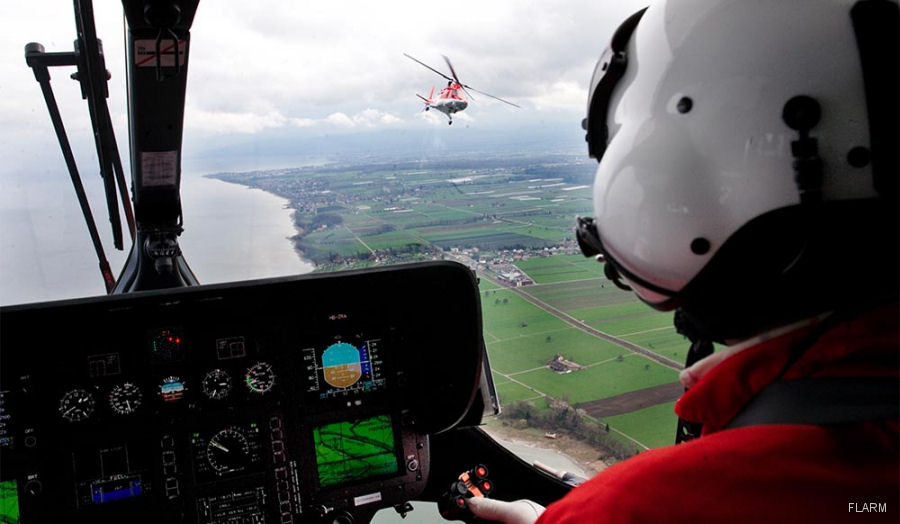
FLARM, May 08, 2019 - EASA has formally approved FLARM for fixed installation in helicopters.
Being already installed in over 40,000 General Aviation aircraft, helicopter operators previously had to apply for individual installation approvals from EASA or use PowerFLARM Portable.
The newly published EASA Certification Memorandum (CM) extends generic FLARM installations from ELA2 aircraft (previously available as a Standard Change or an AML-based Minor Change) to all CS‑23, CS‑27 and CS‑29 aircraft, including all rotorcraft.
“This is a huge advancement for GA safety in Europe”, said Daniel Hoffmann, General Manager at FLARM Technology. “We have seen a massive increase in demand for FLARM from helicopter operators all around Europe in just the last two years. In Switzerland, almost all helicopters already have FLARM since a few years. In Germany and other European countries, many large operators, including the Federal Police, ADAC and DRF, have FLARM installed in their large helicopter fleets”.
The newly published CM will enable both operators and aircraft manufacturers to easily integrate FLARM. It is also one of the first times that EASA has ever applied the ‘Net Safety Benefit’ approach in their certification activities. “EASA has taken the over 100 million flight hours of FLARM into account”, said Hoffmann. “We have estimated that FLARM has saved over 50 lives in the last fifteen years. At the same time, there have been no incidents where FLARM was a causal factor”.
The CM approves FLARM for both VFR and IFR under VMC but does not give credit against ADS-B Out and TCAS requirements (applicable for aircraft above 5,700 kg MTOM).
“This also opens the door for the whole certified avionics market”, said Hoffmann. “We are currently in discussions with several certified avionics manufacturers about both integration of FLARM as well as display compatibility with standalone FLARM systems”.
FLARM systems are available from several different manufacturers for many different aircraft types.
###
FLARM was invented in 2004 by three Swiss glider pilots/engineers, following many fatal mid-air collisions between gliders. Despite the VFR-principle of “see and avoid”, in many situations it’s virtually impossible to see the other aircraft. At that time, mid-air collisions represented the most common cause of fatal accidents in gliding. Most accidents also happened in good visibility and during daylight.
Urs Rothacher, Andrea Schlapbach, and Urban Mäder set off to design a system that would alert the pilots of an imminent collision and tell them where the intruder is, so they could take immediate action.
Everybody that had FLARM of course wanted all their pilot friends to also have FLARM. That way, they could virtually eliminate the risk of a mid-air collision. Consequently, FLARM was heavily promoted by all glider pilots.
As an additional feature, an innovative obstacle collision warning system was integrated with FLARM. Using an integrated obstacle database, the system warns when the pilot is about to fly into a power line, cableway, wind turbine, or other type of obstacle. The advanced collision algorithms make it possible to handle complex obstacle types, including segmented obstacles.
PowerFLARM has antenna diversity, meaning it’s possible to have one antenna on top of the aircraft and one below. It also comes with an ADS-B and transponder Mode-C/S receiver, to maximize the number of aircraft that can be detected.
Today, there are more than 35.000 aircraft flying with a FLARM system installed. In Central Europe, virtually 100 % of gliders have FLARM and would never fly without it. The largest growth is today however within the powered aircraft community.
Being already installed in over 40,000 General Aviation aircraft, helicopter operators previously had to apply for individual installation approvals from EASA or use PowerFLARM Portable.
The newly published EASA Certification Memorandum (CM) extends generic FLARM installations from ELA2 aircraft (previously available as a Standard Change or an AML-based Minor Change) to all CS‑23, CS‑27 and CS‑29 aircraft, including all rotorcraft.
“This is a huge advancement for GA safety in Europe”, said Daniel Hoffmann, General Manager at FLARM Technology. “We have seen a massive increase in demand for FLARM from helicopter operators all around Europe in just the last two years. In Switzerland, almost all helicopters already have FLARM since a few years. In Germany and other European countries, many large operators, including the Federal Police, ADAC and DRF, have FLARM installed in their large helicopter fleets”.
The newly published CM will enable both operators and aircraft manufacturers to easily integrate FLARM. It is also one of the first times that EASA has ever applied the ‘Net Safety Benefit’ approach in their certification activities. “EASA has taken the over 100 million flight hours of FLARM into account”, said Hoffmann. “We have estimated that FLARM has saved over 50 lives in the last fifteen years. At the same time, there have been no incidents where FLARM was a causal factor”.
The CM approves FLARM for both VFR and IFR under VMC but does not give credit against ADS-B Out and TCAS requirements (applicable for aircraft above 5,700 kg MTOM).
“This also opens the door for the whole certified avionics market”, said Hoffmann. “We are currently in discussions with several certified avionics manufacturers about both integration of FLARM as well as display compatibility with standalone FLARM systems”.
FLARM systems are available from several different manufacturers for many different aircraft types.
###
FLARM was invented in 2004 by three Swiss glider pilots/engineers, following many fatal mid-air collisions between gliders. Despite the VFR-principle of “see and avoid”, in many situations it’s virtually impossible to see the other aircraft. At that time, mid-air collisions represented the most common cause of fatal accidents in gliding. Most accidents also happened in good visibility and during daylight.
Urs Rothacher, Andrea Schlapbach, and Urban Mäder set off to design a system that would alert the pilots of an imminent collision and tell them where the intruder is, so they could take immediate action.
Everybody that had FLARM of course wanted all their pilot friends to also have FLARM. That way, they could virtually eliminate the risk of a mid-air collision. Consequently, FLARM was heavily promoted by all glider pilots.
As an additional feature, an innovative obstacle collision warning system was integrated with FLARM. Using an integrated obstacle database, the system warns when the pilot is about to fly into a power line, cableway, wind turbine, or other type of obstacle. The advanced collision algorithms make it possible to handle complex obstacle types, including segmented obstacles.
PowerFLARM has antenna diversity, meaning it’s possible to have one antenna on top of the aircraft and one below. It also comes with an ADS-B and transponder Mode-C/S receiver, to maximize the number of aircraft that can be detected.
Today, there are more than 35.000 aircraft flying with a FLARM system installed. In Central Europe, virtually 100 % of gliders have FLARM and would never fly without it. The largest growth is today however within the powered aircraft community.

See also |
Helicopters Avionics FLARM
EASA European Commission




